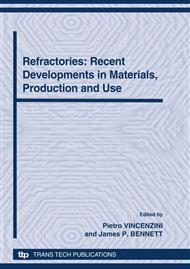p.141
p.150
p.160
p.167
p.173
p.179
p.193
p.199
p.205
Selection Criteria and Tools for Refractory Materials to Be Used in Pulverised Coal Combustion (PCC) Reactors
Abstract:
Criteria and tools are presented for the selection of appropriate refractory materials to be used in pulverised coal combustion reactors for the production of electrical energy. One of the main causes of failure of refractory materials is the high temperature corrosion due to chemical attack of the slag formed from the coal ash and possible additives. Selection criteria are based on the phenomena involved in the corrosion mechanism. The developed tools are based on thermodynamics of chemical reactions between oxides systems and permitted to evaluate the classes of materials in terms of chemical corrosion resistance as a function of slag composition and temperature. The effects of the chemical interaction between slag and refractory on the physical and chemical properties of the slag, such as viscosity, melting point, change of composition, solid phase formation, were also investigated. Experimental tests resulted in agreement with the indications obtained from the thermodynamic evaluation. Preliminary evaluation is an important tool for reducing the number of laboratory trials often expensive and time consuming. These chemical aspects are complementary to the engineering plant aspects and must be taken into consideration for a successful realization of the process.
Info:
Periodical:
Pages:
193-198
Citation:
Online since:
October 2010
Authors:
Price:
Сopyright:
© 2010 Trans Tech Publications Ltd. All Rights Reserved
Share:
Citation:


